SaaS Purchasing and Cloud Spend Insights Q1, 2024
.webp)
Take a self-guided tour of the platform.
See why Vertice is trusted by top procurement leaders.
2023 wasn’t dubbed the “Year of Efficiency” without good reason. 262,595 jobs were cut in the tech sector alone, AI software spending skyrocketed, as companies looked for ways to become more productive, and there was an all-round greater focus on cost optimization.
But does this mark the end of what has been a relatively frugal year for many?
We doubt it.With inflation not quite sliding as steadily downwards as we’d like – the UK has even seen a small upward turn, though this is expected to be temporary – financial prudence remains top of mind for the majority of organizations.
And while many are generally more optimistic about their financial prospects, we’re not entirely out of the woods just yet.As a result, we expect to see companies continuing to do more with less this year. Perhaps even more so across two of their most expensive line items – SaaS and cloud.
With this in mind, we decided to combine our SaaS and cloud insights into one, to offer you double the intel in one go. So here goes…our SaaS purchasing insights for Q1, 2024, followed by our cloud spend insights further down.,
SaaS purchasing insights
Share of spend for new software purchases is rapidly decreasing
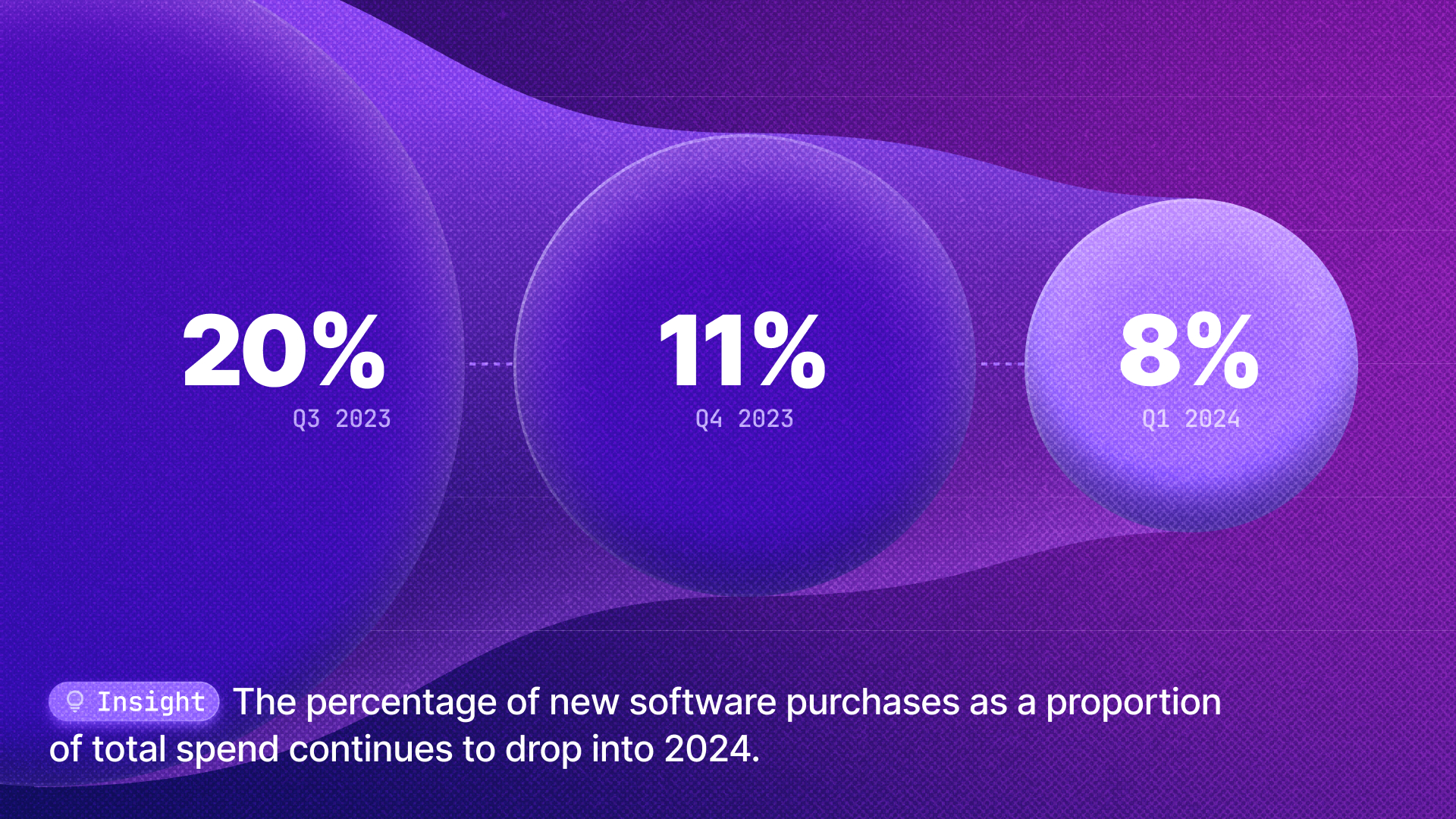
When it comes to software spending, renewals have always accounted for a much larger slice of the pie. And often for good reason – familiarity, cost-effectiveness, minimal disruption to name but a few.
Despite this, new applications have continued to make their way into an organization’s SaaS stack, whether as a replacement to a previously used tool, or as a never before used type of software.
Here’s the thing though – share of spend for these new purchases are declining. Rapidly.In Q4 of 2023, new software purchases accounted for just 11% of total SaaS spend, a significant drop from the 20% reported in Q4 of the previous year. And it’s not looking any better for 2024.
By the end of this quarter, we project that the number could fall to as low as 8%. Meaning that as much as 92% of the average organization’s SaaS budget will be reserved entirely for renewals.
So, what exactly does this tell us? In short, that organizations are becoming increasingly cautious – and ultimately less frivolous – when it comes to the procurement of new tools.
But, according to our Global Head of Purchasing, Nick Riley, this is something that companies can use to their advantage.,
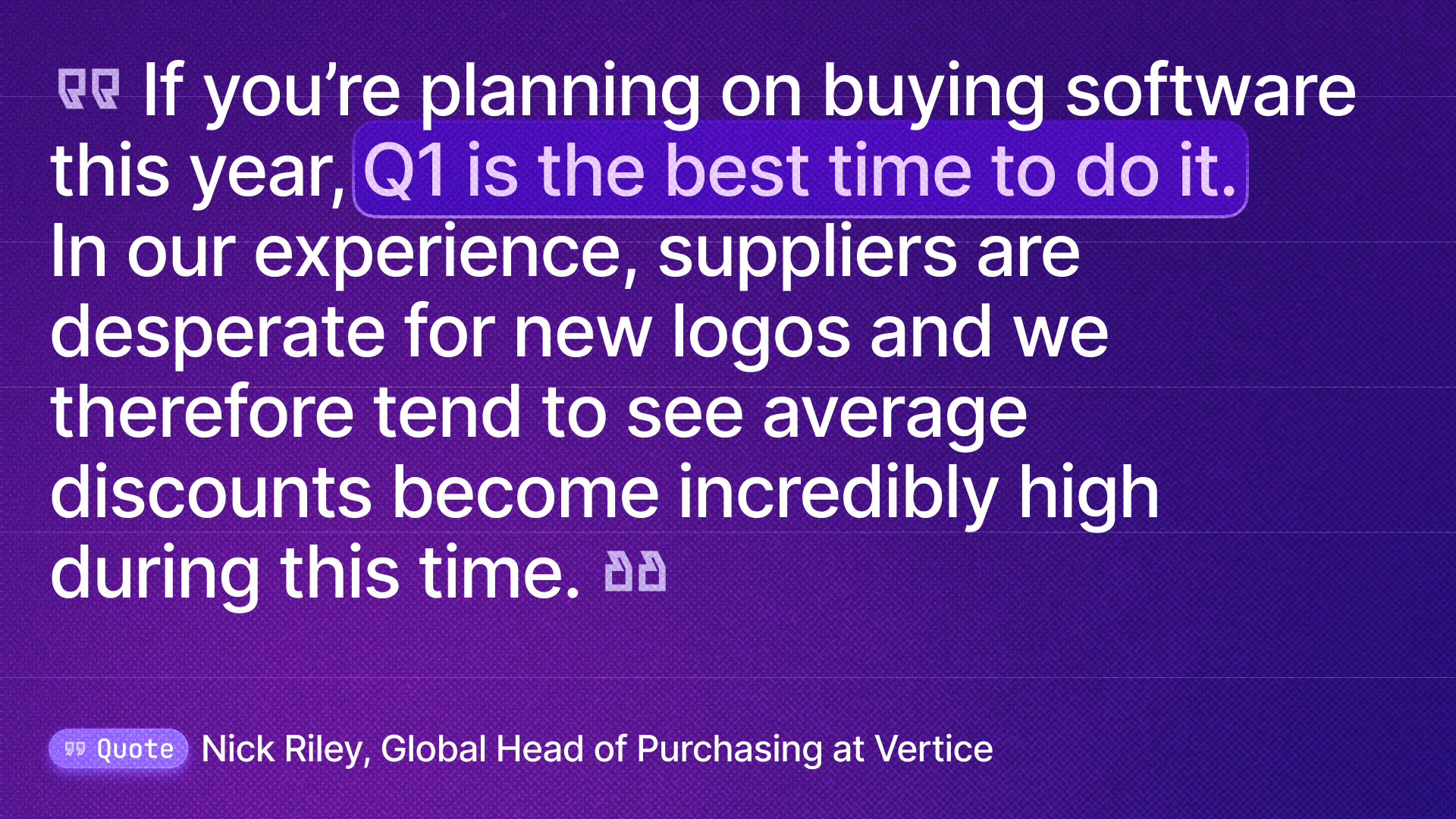
Renewals take 50% longer to negotiate than new purchases
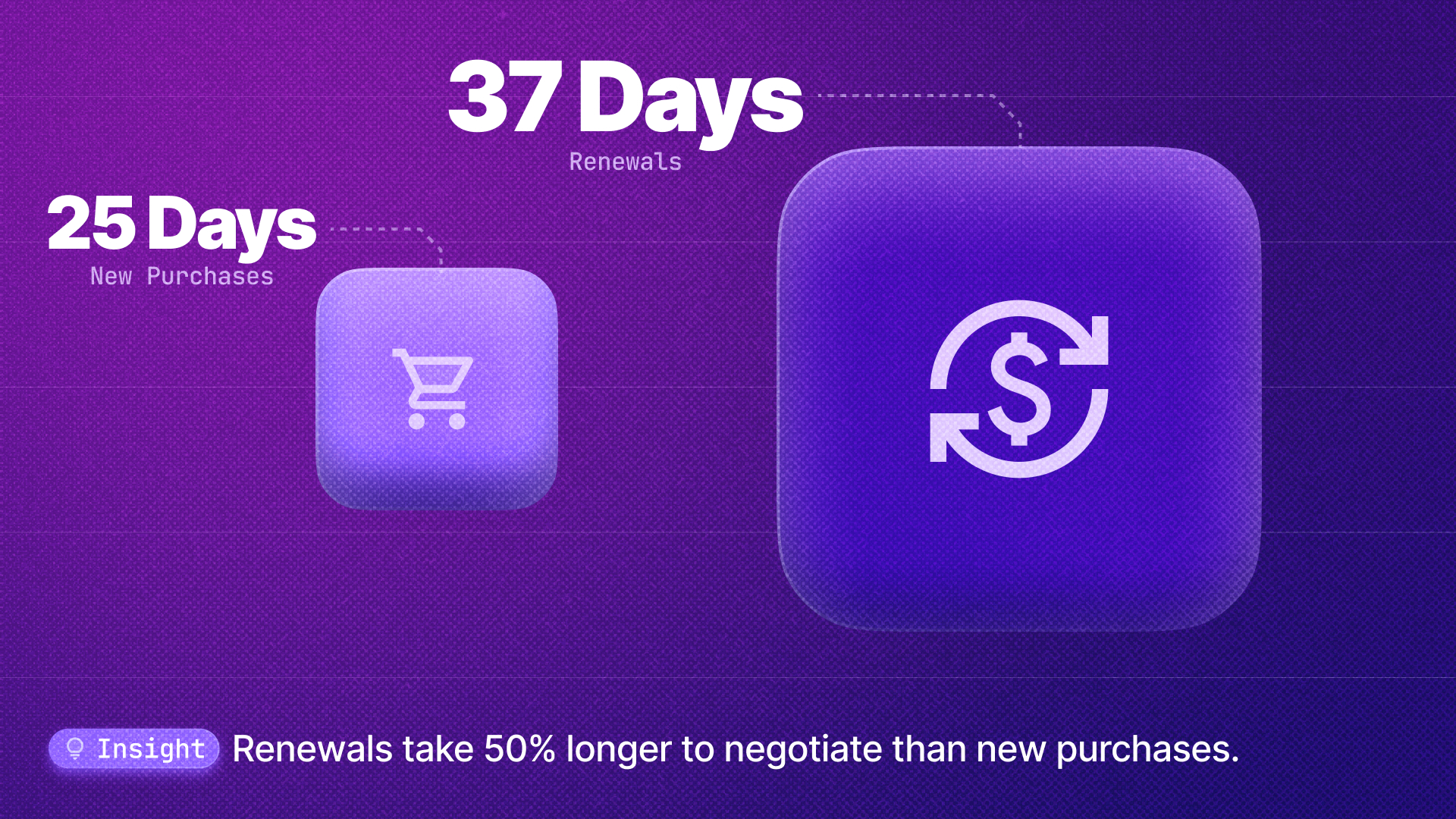
Renewals may be dominating the average organization’s SaaS budget, but it’s not just the cost that companies need to factor in.
It’s also time. According to our data, renewals often take 50% longer to negotiate than new purchases, with the latter taking an average of 25 days, compared to 37 days for renewals. Counterintuitive though it may seem, there’s a logical reason – when it comes to buying new software, much of the initial research is done informally before initiating any sort of purchase request.
For renewals, however, the process is often more reactive, with stakeholders only starting the requirements gathering process once they realize the renewal deadline is approaching – and that’s assuming they realize at all.
But it’s not the only reason they take longer.When renewing SaaS contracts, many companies also want to renegotiate the terms, licenses and costs – which comes as little surprise, given how 33% of contracts allow vendors to increase their pricing. In certain industries, such as email marketing and accounting, this figure rises to 71% and 50%.Now throw the need to evaluate alternative solutions and delayed vendor response times into the mix, and the timing issue becomes even more apparent.
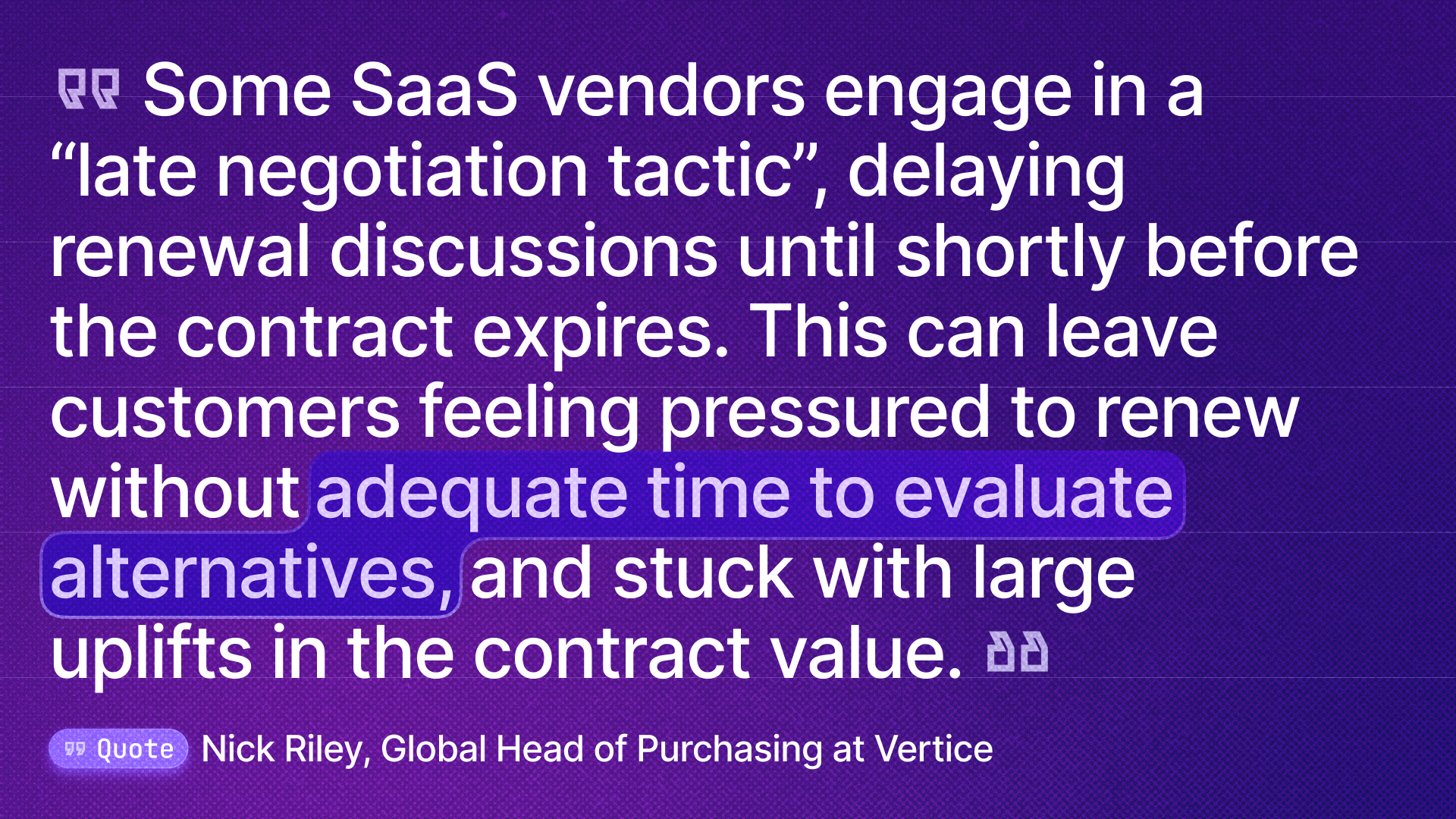
What is interesting, though, is that the total time to negotiate contracts end-to-end is almost entirely independent of the size of the deal. Which ultimately means that tackling the long tail is just as valuable in terms of opportunity cost as tackling the more strategic, key contracts.But while deal size may not influence negotiation time, the complexity of a software application often does.
Our data indicates that market-leading, legacy vendors with complex products and add-ons often require the most time. Microsoft, for example, has the longest cycle at 60 days, with Salesforce not far behind.
In contrast, vendors with a relatively simple product offering such as Asana, Workable, and Crossbeam are often the quickest to negotiate.Regardless of the tool in question, it’s crucial that you allow sufficient time for renewals, or better yet that you work with a SaaS procurement partner, such as Vertice, that can handle renewals on your behalf.

What's trending in SaaS?
Most popular new purchases
New software purchases may be declining on the whole, but there’s still been a surge in popularity for certain tools. In fact, the fastest growing SaaS categories across our user base include customer support tools, HR platforms, and DevOps applications.
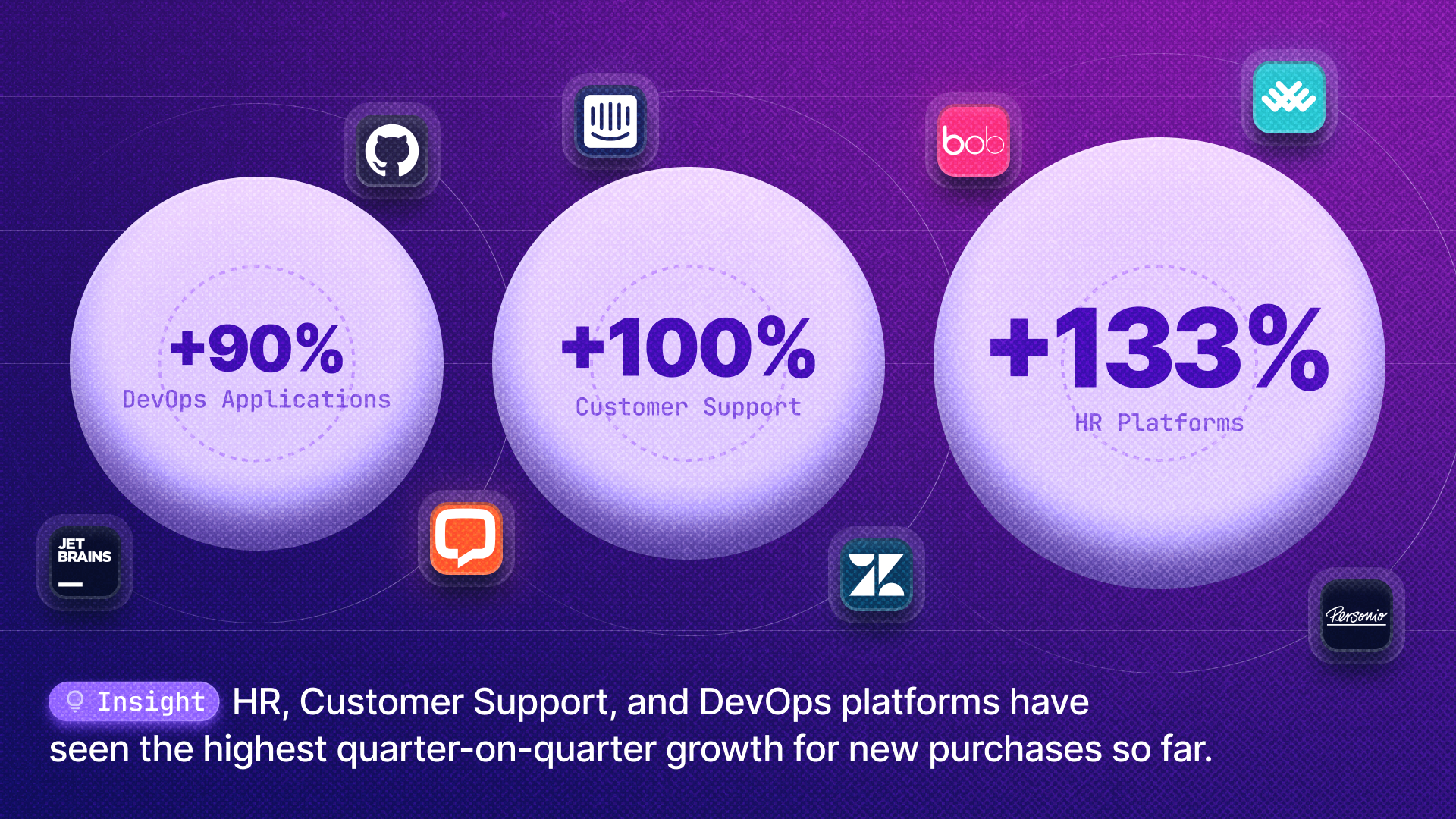
But why are these types of tools in such high demand?
One reason comes down to their AI capabilities.As companies look for ways to boost both efficiency and productivity, they’re naturally gravitating towards those that can automate and streamline certain tasks. For customer service teams, this includes utilizing tools such as Zendesk, Klaus and Intercom, which offer chatbot functionality and can automatically resolve customer queries.
Similarly, for DevOps teams, there’s a huge benefit to using software such as GitHub, JetBrains and Dagster, which offer the likes of code completion, while also being able to fix bugs – both resource-intensive tasks.
Most popular renewals

When it comes to the most popular software renewals, it’s product categories such as sales engagement, recruitment, and mobile device management that are topping the charts.
The question is, why?
To start with – and as mentioned in our roundup of trending SaaS applications in 2023 – companies are still very much hot on the tools that enable growth and that support their go-to-market strategies. But what’s really making the likes of Outreach and Gong all the more lucrative is their AI functionality, with users now able to access features such as automatic meeting summaries and sentiment analysis.
Another type of software that’s seen a recent surge in renewals is recruitment platforms such as LinkedIn, Greenhouse and Personio, indicating that amidst the continuous news of layoffs, hiring quite clearly remains a top priority for many organizations.
The software category that’s seen the highest jump in renewals, however, is the mobile device management sector, with providers such as Jamf and Kandji experiencing record growth. This tells us that security remains paramount to the majority of companies, which comes as little surprise following increased security concerns off the back of the recent Microsoft breach and the 2023 LastPass hack.
Rising software vendors
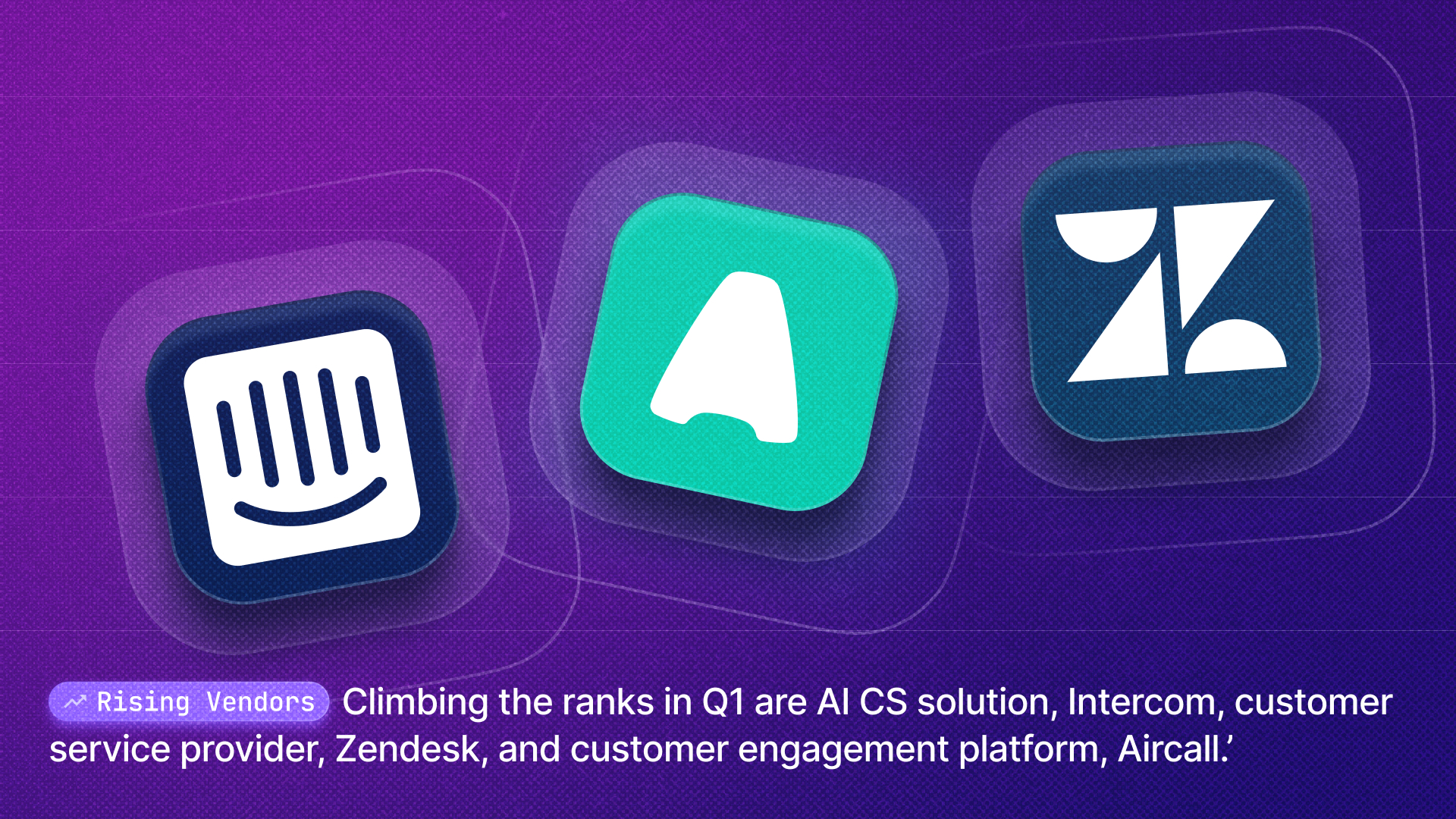
Customer service platforms are certainly having their moment.
Of all the SaaS solutions used across our customer base, it is AI customer service software, Intercom, customer service provider, Zendesk, and customer communication and engagement platform, Aircall, that have seen the highest uptake between Q4, 2023 and Q1, 2024.
The surge in demand for these tools is somewhat unsurprising, given the need for maximum efficiency.Not only does it reportedly cost five times more to acquire a new customer than retain an existing one, but research further indicates that increasing customer retention by 5% can increase profits by anywhere from 25-95%.
Falling software vendors

What goes up, must come down. Or so they say.Unfortunately, since last quarter, the tools that have seen the biggest decline in usage across our customer base include go-to-market software provider, ZoomInfo, video communication platform, Zoom, and cloud data solution, Snowflake.
Given the vital role that video communication platforms play within the average organization, it’s certainly surprising to see market-leader Zoom feature so prominently on this list.What’s perhaps more interesting is that we’re seeing an increasing number of customers switch to the likes of Microsoft Teams, which is substantially more affordable – highlighting the very real impact that rising software prices are having on companies and their decisions around optimizing their SaaS stacks.
Q1 vendor hero: Intercom
With the highest increase in purchases and renewals across our user base, this quarter’s vendor spotlight is on AI customer service platform, Intercom.
With the share of spend for AI software having more than tripled in 2023, it comes as little surprise that tools of this kind are rising in popularity. And with a 4.5 star rating on G2, based on almost 3,000 user reviews, it’s also clear why Intercom in particular has become an increasingly sought-after platform.


Back in 2020, McKinsey predicted that AI technologies had the potential to deliver up to $1 trillion of additional value each year, with customer support tools expected to account for a significant portion.
Well, given the data, it seems as though the company may have just been onto something. Not only do all three of our rising vendors belong to this very software category, but customer support platforms in general now account for 7% of total SaaS spend within the average organization, making it the 5th largest category in terms of spending.
As with any tool though, prices are rarely set in stone and there are almost always opportunities to drive down the cost.Our data indicates that the average discount provided by vendors in this space is 19%, meaning that you could be saving almost a fifth of the list price with the right leverage and negotiation strategy, often substantially more.
Cloud Spend Insights
Reserved Instance Usage increased significantly from 13% to 20% year-over-year
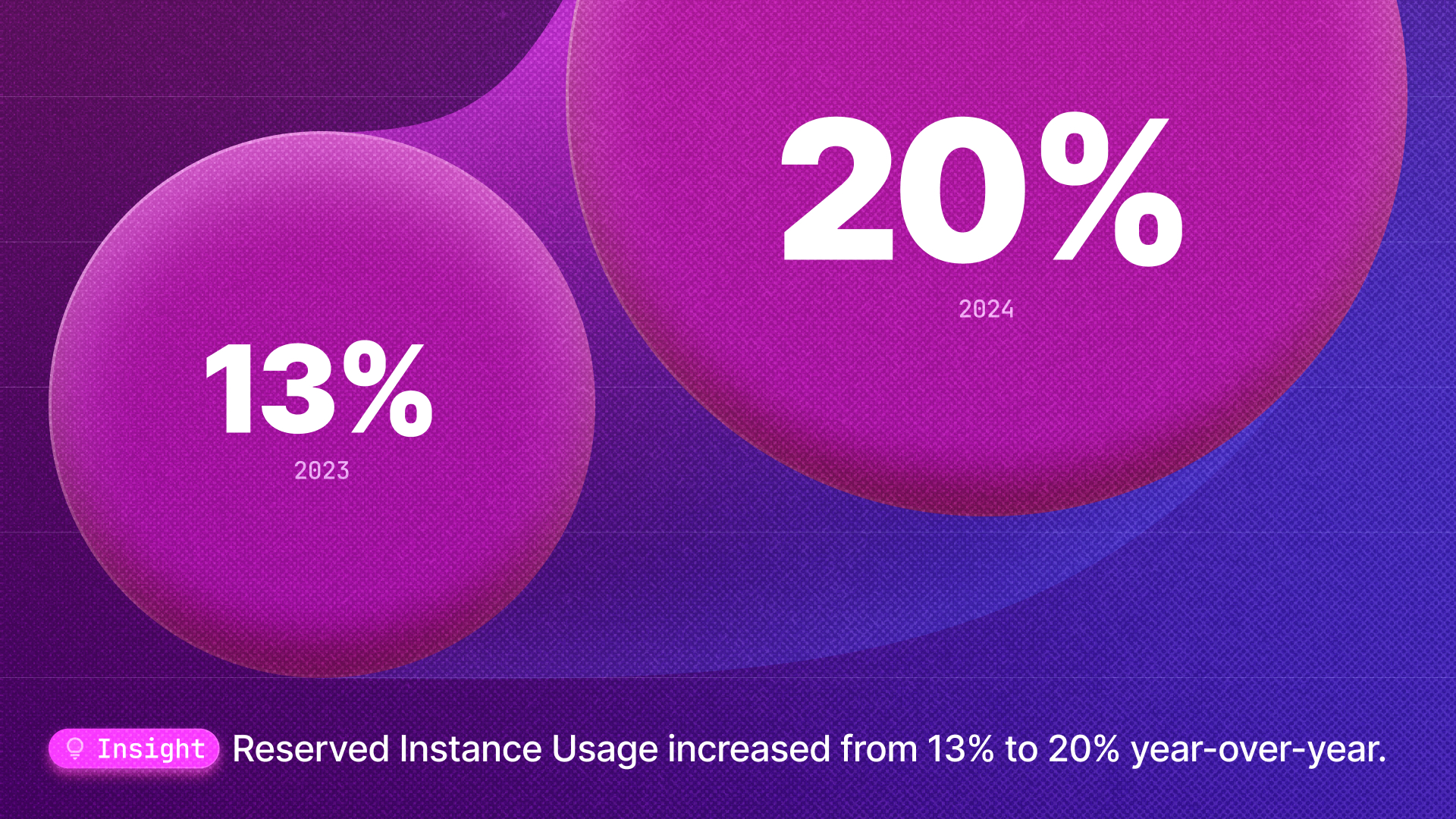
Wasted spending has long been an issue for organizations, but with the spotlight now well and truly on efficiency, companies need to be doing all they can to keep it to a minimum. Or better yet, eliminate it altogether.
With close to a third of the average organization’s cloud budget going entirely to waste, it’s unsurprising that this line item in business spending is becoming a key area of cost optimization.So much so that reserved instance (RI) usage has increased from 13% to 20% year-over-year.According to our Senior Insights Manager, Ethan Elstein, this is almost certainly the result of companies looking for opportunities to drive down spend.

Implementing reserved instances isn’t a miracle cure to eliminating cloud wastage, though. It only works if you are effectively utilizing them.Which is where Vertice’s RIO capabilities come in. By eliminating the burden of manually managing your discount commitments and automatically optimizing your RI coverage, we can help you cut your compute spend by as much as 60%.

AWS costs are becoming even harder to predict
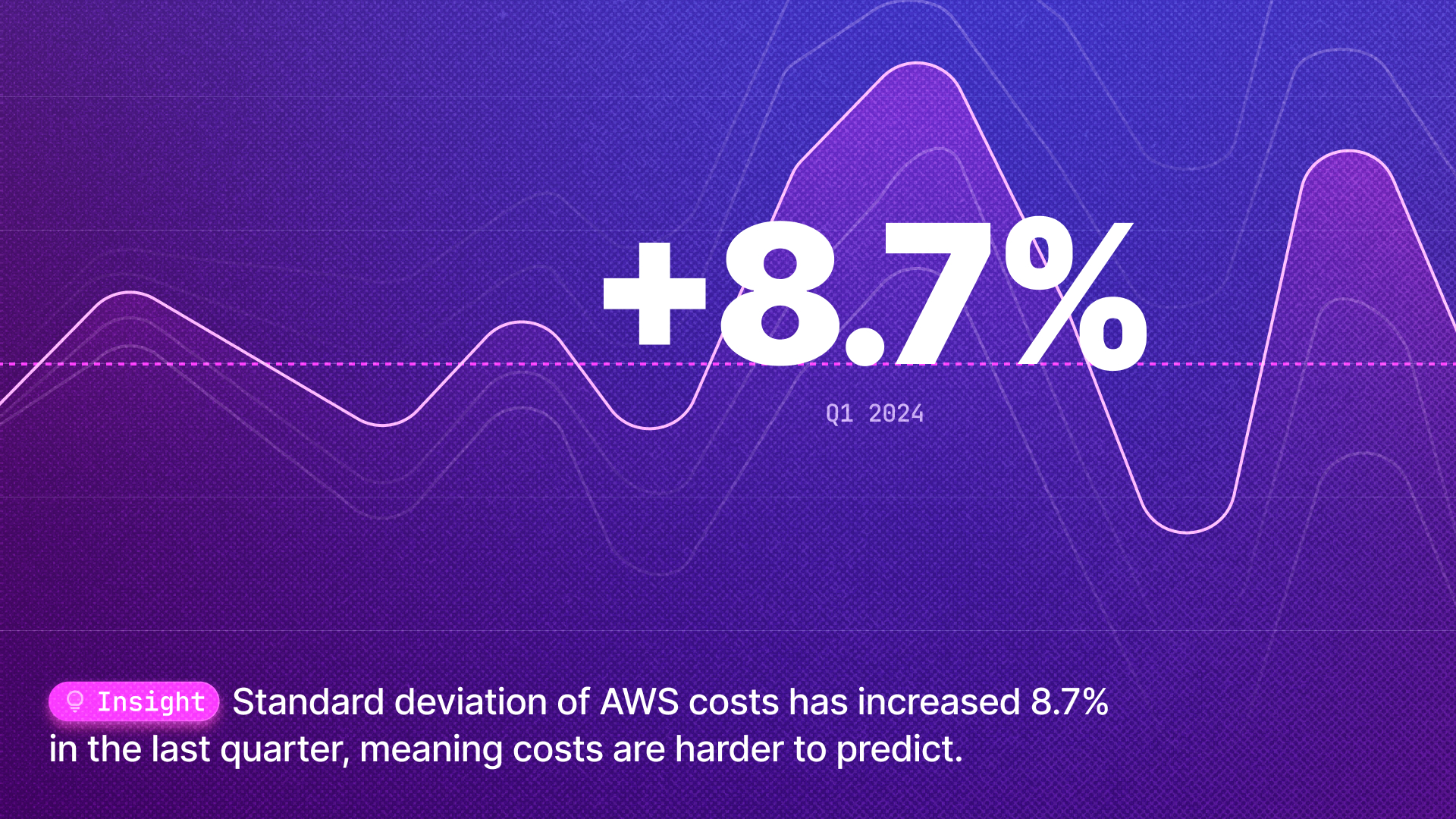
Standard deviation of AWS costs has increased 8.7% in the last quarter, indicating that the costs associated with using the cloud provider are becoming all the more unpredictable and volatile.
And it’s a huge problem for finance leaders.The inability to accurately forecast any business cost is problematic, but when you consider how cloud spending accounts for as much as 11% of an organization’s total spend, the severity of the issue is all the more apparent.
But why is it happening? And what can be done about it?
AWS cost variations can occur for a number of reasons, such as changing usage patterns, inadequate AWS resource management practices, service utilization, periodic changes to pricing models, and so on.Being in a position to mitigate these challenges is therefore fundamental.
Which is where cloud cost optimization comes into play.By providing you with full oversight of your AWS usage and spend, you can more accurately attribute your costs and forecast spend. With a platform such as Vertice, you will also be alerted in real-time to any irregularities in your usage that may impact your cost.
AWS cost leaderboard
Below, we’ve provided a breakdown of the top 10 AWS services by share of spend in the final quarter of 2023, along with a look at how it compares to the previous quarter.

Amazon Elastic Compute Cloud, also referred to as EC2, once again tops the leaderboard, which comes as little surprise, given how compute costs account for the largest share of cloud spend within the average organization.
It’s not the only reason we may have seen an increase in demand during this time, though.
With traffic often increasing significantly during the holiday season, particularly the Black Friday weekend and Christmas period, companies will often scale their EC2 instances during these peak times.
But while the share of spend for this service has seen a noticeable increase between the two quarters, it is actually AWS Support (Enterprise) that has experienced the largest growth, jumping from 2.59% to almost 5%.
Unfortunately, where there are winners, there are losers.
In terms of the AWS services that have seen the biggest decline in share of spending, Amazon Relational Database Service tops the charts with its share of spend falling from 16.32% to 13.8%. One of the likely reasons for this is due to companies increasingly switching to AWS alternatives, such as Aurora.

SaaS and cloud: better together
Accounting for around 25% of a company’s total cost base, SaaS and cloud have fast become two of the most prominent outgoings in any modern business.
The problem? They’re also two of the most difficult areas of spending to control.
Or at least they used to be.
As the world’s first ever platform for both SaaS and Cloud Spend Optimization, Vertice is uniquely positioned to provide you with unparalleled visibility of both, enabling you to tackle the major issue of soaring prices and wasted spend.
But it’s not just money we’ll save you – for the record, we’re talking savings in the millions. We can also save you a substantial amount of time – time negotiating on contracts, time managing your cloud discount commitments, and even time dealing with complex approval processes.That’s hours back in your day, and days back in your week.
See for yourself how much you could be saving, or alternatively read how one company was able to map its entire cloud and SaaS costs into one dashboard, providing the cornerstone for a spend review project that would save the company more than €500,000 in just six months.
.webp)


![The Best SaaS Management Platforms for 2026 [According to Analyst Research]](https://cdn.prod.website-files.com/6640cd28f51f13175e577c05/687f56f6e55f8c0078341eb6_2025-06-Lionfish-Tech-Advisors-Report-01-1080x1080.webp)


.webp)